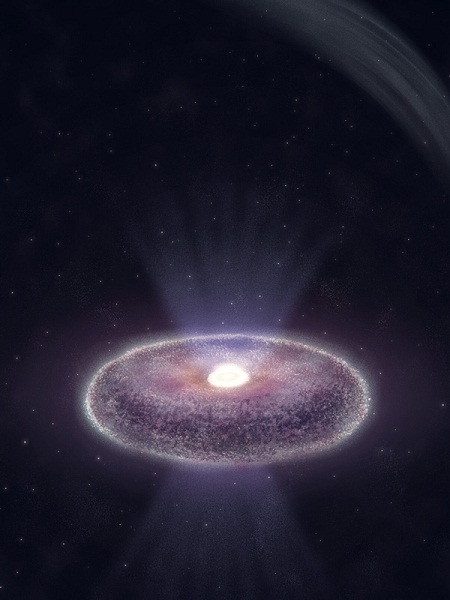SRON scientists have found first evidence of an ionized gas wind far away from a supermassive black hole at the centre of a galaxy. The discovery of this outflow, near the boundary of the galaxy, may contribute to solving a long standing mystery. How do these ‘tiny’ black holes in the centre influence the evolution of the vast host galaxies?
Black holes are common objects in our universe: each galaxy in the universe hosts a supermassive black hole (with a mass up to billions of suns) in its centre. A supermassive black-hole has approximately the size of our solar system, while the host galaxy is billion times larger. Nevertheless, the radiation and the outflow of gas resulting from the violent conditions near the black hole strongly determine how the entire galaxy evolves with time.

A black hole itself does not emit any light. However, when a black hole is active, the matter falling onto it releases an enormous amount of energy in the form of observable radiation. This radiation ionizes the surrounding gas clouds, changing the way the clouds absorb radiation. The absorption effects are very apparent at specific wavelengths of the light, which are visible as lines in the observed spectrum. These lines convey a wealth of information about the composition and motion of the gas surrounding the black hole. For any astronomer able to decode the message, pointing a spectrometer to a supermassive black hole is like having a camera recording its activity.
A shy black-hole
SRON scientists are leading worldwide experts in ”decoding” high-resolution X-ray spectra of active black holes. Recently the analysis of deep spectra of a distant, active black hole – obtained from the XMM-Newton and Hubble space telescopes – led to unexpected results. SRON PhD student Laura di Gesu, first author of two papers in Astronomy & Astrophysics: “For decades, this black hole has been famous for switching on and off very often, and scientists have put forward many explanations for this. Using spectra obtained from XMM-Newton and Hubble observations we now show that it switches off just because sometimes it is obscured by gaseous clumps.” This suggests that from our viewpoint on Earth the system is not oriented exactly face on.
Outflow
A second, more important discovery is that Di Gesu found that the X-ray light emitted by the gas close to the central black hole is absorbed by a weakly-ionized gas cloud, which is slowly flowing away from it. ”This was the real surprise about this black hole. We were lucky enough to be able to locate the outflow, discovering for the first time a gas located very far away from the nucleus, almost at the host galaxy boundary,” says Di Gesu.
”Black-hole driven winds are common in nearby active galaxies,” adds Elisa Costantini, Di Gesu’s supervisor at SRON. ”But usually they are too weak to be the mechanism by which the black hole influences the evolution of the host galaxy. This outflow is also very weak, but the fact that it is located at a very large distance may indicate that it is a relic of a past, much more powerful wind.”
Di Gesu and her team showed that a ‘tiny’ black hole is able to blow a wind up to the boundary of the host galaxy. This discovery is an important step forward for solving the mystery of the coevolution of galaxies with their central black hole.
Publication
These results have led to a scientific publication in the European journal Astronomy & Astrophysics, The publications “Simultaneous XMM-Newton and HST-COS observation of 1H 0419-577. I.The absorbing and emitting ionized gas.” and “II. Broadband spectral modeling of a variable Seyfert galaxy.” are now online.
http://arxiv.org/abs/1305.6232
http://arxiv.org/abs/1401.5614


